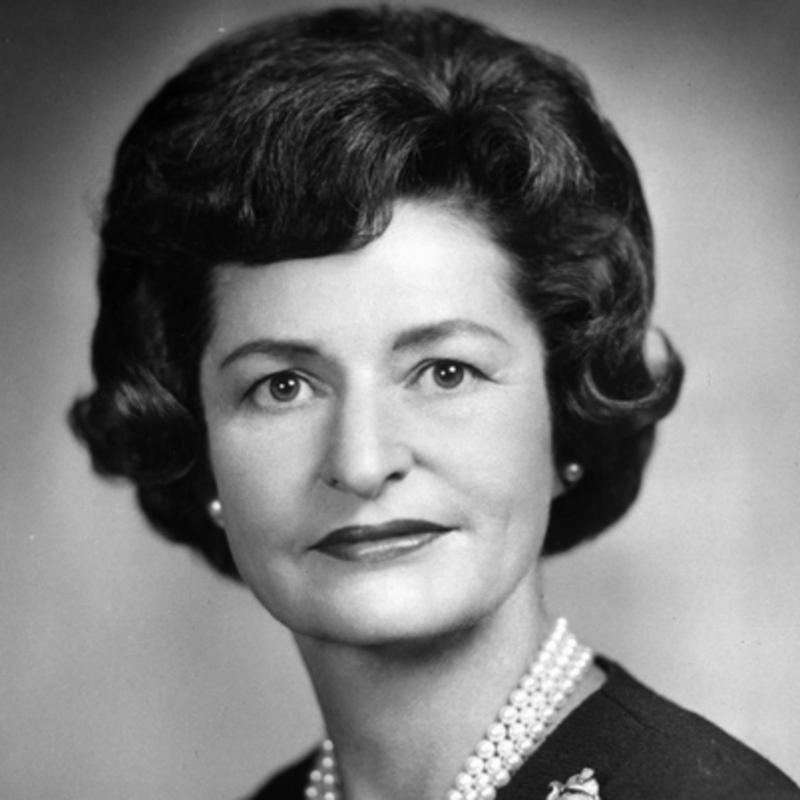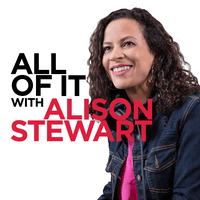[music]
Alison Stewart: This is All Of It. I'm Alison Stewart, and here we are nearing the end of our Presidents' Day show about presidential spouses, aka some very cool first ladies. This hour we're talking about Lady Bird Johnson, who had big shoes to fill when she unexpectedly took over the first lady's office from the nationally beloved Jackie Kennedy. In her role as first lady, she became a shrewd adviser to her husband, a seasoned political pro who knew politics and the president better than anyone, which became clear near the end of Lyndon Johnson's presidency, a presidency Johnson was ambivalent about the entire time.
Let's get into the final installment of my conversation with Julia Sweig, author of Lady Bird Johnson: Hiding in Plain Sight and host of the podcast of the same name. We will join the story with the final year of the Johnson presidency, and then we'll explore the final years of Lady Bird's life.
[music]
Alison Stewart: Julia, you write in the book, at the beginning of 1968 Lady Bird came to believe "the presidency was no longer a place from which she and her husband could do their best for their country or their family". What was the main reason that she thought they could no longer be effective?
Julia Sweig: Well, the protest movement against the war really hit hard to her when she goes up to New England at the end of 1967, in the fall of 1967. She is trying to sprinkle her fairy dust on the launching of two environmental studies programs at Williams and at Yale. I shouldn't demean it by saying sprinkle her fairy dust. By then she's seeing herself as a committed environmentalist, and she's trying to promote an interdisciplinary approach to environmental studies. It's quite visionary, but she gets up there, and she's totally drowned out by anti-war protesters. She has lost her ability to distance herself.
She had, I think, benefited from her own stature and standing and being the first lady and being a little bit more untouchable compared to Lyndon around Vietnam, but that wall totally falls by fall of '67 and she's just a target just like LBJ. She comes back, and she says, "I really can't be in a bubble." She thinks that the campus protesters are themselves fascists and that it's not cool to do anything but oppose the Vietnam War. She doesn't like that uniformity, but she still feels and sees that the country has turned against them. I do think it's really Vietnam, number one.
Number two, she, as we talked about, is very mindful of LBJ's life on this planet and of the potential that in a second term he might become very ill while in office or die. She wants to try to have a life with him after the presidency, so his health and his well-being, their ability to enjoy grandkids and one another and get out of the limelight and keep him alive is another huge piece of it for her and for him.
Alison Stewart: She describes him as having a great load off his shoulders once he announces he would not seek reelection in '68. What about her? Was she happy to exit the presidential stage?
Julia Sweig: Oh, I think she was delighted. She's a person who counts everything. If she's driving down the road, she's counting the crape myrtle trees that they planted the year before to see how each one of them is doing. She's counting the days. In late '65, early '66, she's starting to actually record the number of days she still has to go. She loves being in the White House. She describes the heady atmosphere and access to interesting people she has the privilege to have, but she's delighted to get out.
I think the grandkids that her young daughter has started having one, then Linda becomes pregnant, so by the time the exhaustion that she talks about, not just his depression and his exhaustion, but her depression and her exhaustion, it takes a huge toll. A huge toll.
Alison Stewart: The description of writing with the Nixon's to the inauguration was a little bit shocking, but given how she's such a gracious person, not that she wasn't gracious, but that it was so cold. The way that you describe it in the book, it seemed just very cold and almost, for me, I [unintelligible 00:05:29] got to say a little bit out of character.
Julia Sweig: Well, the coldness-- By January of 1969, what has transpired between Richard Nixon and Lyndon Johnson is that Richard Nixon has actively sought to undermine LBJ's attempt to have peace talks with the North Vietnamese. By the time they're together at the White House on the morning of the inauguration and then Lady Bird and Pat driving over together, Lady Bird's not feeling very warm toward Pat, even though they've known one another for years because Lyndon has just had to stomach knowing what Nixon has done to try to undermine his election but certainly to undermine him in Vietnam. I think that's part of it.
Alison Stewart: My guest is Julia Sweig. We're talking about Lady Bird Johnson: Hiding in Plain Sight, also a podcast. Once they leave the White House, does she continue her environmental work?
Julia Sweig: She does. She does it in a couple of different ways, but the most important way is twofold, and it's in Austin, Texas. In the 1980s, she found something called the Lady Bird Johnson Wildflower Center, which, if you go there today, what you'll see is it is a place where one can learn about nature and wildflowers, but it's also a center for environmental education with a lot of work done to teach young kids, especially about climate change mitigation and about the use of native plants in order to retain soil and prevent recession and all kinds of elements of climate change.
Again, it's called the Lady Bird Johnson Wildflower Center and Texans will tell you that they adore her for her devotion to the gorgeous bluebonnets that are blooming right around now or just a little bit past. The other thing she did though was, we talked a little bit about the enterprise that never came to be along the Anacostia River on Kingman Island and its adjacent surrounding. She did bring that idea to Austin, Texas, and she put her time and energy behind fundraising and pushing politically for what is today called Lady Bird Lake. It was called Town Lake, and it's a dammed area of the Colorado River.
That's a beautiful spot for boating and recreation and also for the construction throughout Austin of urban trails and parks that she pushed for, which is what she had in mind for the Anacostia area of Washington DC.
Alison Stewart: Lyndon Baines Johnson died in 1973. Lady Bird was barely 60 years old, at least she lived another 34 years. What was memorable about this time in her life, her later years?
Julia Sweig: I think if she were to answer that question, it's that after a totally consuming life with that blizzard of activity Lyndon Johnson, that demanding, needy, anxiety-ridden ball of energy and emotion and brilliance, she had the ability to calm things down. They had no work-life balance during their years together, but in her post-presidency, as they call it, she spent time traveling all over the world with her grandchildren and her daughters and with her friends. She had more of the kind of life that a travel bug like her had maybe imagined she would have but as a private citizen more or less, so way, way, way toned down.
The other thing that she spent her time doing was building up the LBJ Presidential Library, which is as an institution, a place that's-- It's part of the National Archives system, but each presidential library has the character of the president and the first lady's, the mark they want to put on it. Both of them, and Lady Bird in particular, given her training, were interested in as much transparency as possible because their presidency was so tarnished by Vietnam that they knew that the whole story would have to be told much, much later.
Lady Bird is the person who, in 1995, makes the decision to release the secret LBJ tapes that he recorded in the White House. She's, of course, the person who authorizes the total release of her own tapes, in addition to so many other documents about the presidency.
Alison Stewart: The title of the book is Hiding in Plain Sight. What had been hidden about Lady Bird Johnson all these years?
Julia Sweig: Well, almost everything, because she's a person who seems to have this two-dimensionality to her looking as an outsider. What had been hidden was her power and influence in shaping LBJ's presidency, his reliance on her for advice as a strategist, her environmentalism that lay behind that euphemism called beautification, and I think her sheer grit and intelligence in the ability to master so many different issues. The last thing I'll say, Alison, and we didn't talk about this so much, is actually her feminism.
She was a person, too, who I think took as a matter of right and destiny that women, herself included, but other women have a duty to be political actors, to participate on the national, local, and world stage. Actually, she talked about the total woman, the complete woman, 20 years before Helen Gurley Brown said that women ought to be able to have it all. I think it's masqueraded in that quaffed first lady image that she put out, but her feminism is also an important and surprising aspect of this woman.
Alison Stewart: That is All Of It for today. Thank you for being with us. All Of It is produced by Andrea Duncan-Mao, Kate Hinds, Jordan Lauf, Simon Close, Zack Gottehrer-Cohen, L. Malik Anderson, and Luke Green. Catherine St. Martin is our intern. Zach Gottehrer-Cohen put together today's show. Megan Ryan is the head of live radio. Our engineers are Juliana Fonda, Shayna Sengstock, and Jason Isaac. Luscious Jackson does our music. I'm Alison Stewart. I appreciate you listening, and I appreciate you. We will meet you back here next time.
Copyright © 2023 New York Public Radio. All rights reserved. Visit our website terms of use at www.wnyc.org for further information.
New York Public Radio transcripts are created on a rush deadline, often by contractors. This text may not be in its final form and may be updated or revised in the future. Accuracy and availability may vary. The authoritative record of New York Public Radio’s programming is the audio record.


